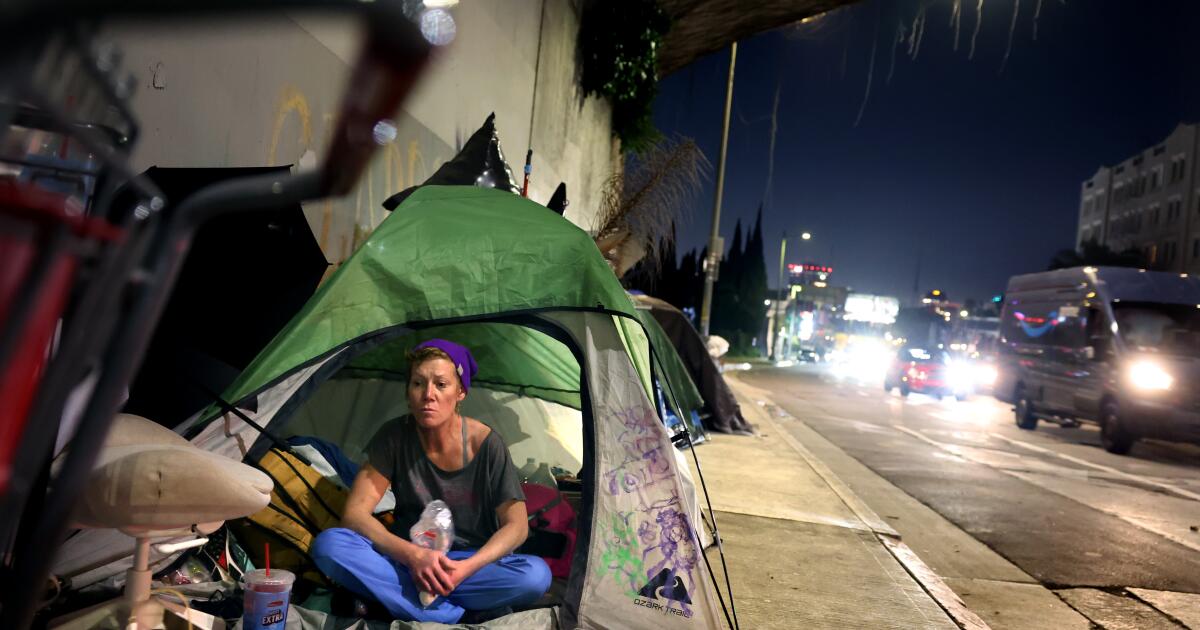The fire that broke out on Franklin Avenue last month was, by some measures, a modest one.
But with winds blowing in the Cahuenga Pass that night, it had the potential to be destructive. Embers from the fire, which started at a homeless encampment, landed on a nearby apartment building, Fire Department officials said. By the time the blaze was out, it had scorched a nearby tree, destroyed two cars and sent smoke into nearby homes.
“It smelled like burning fuel, burning plastic,” said one Hollywood resident who lives nearby.
The fire that burned on Jan. 7 broke out in the first neighborhood targeted by Inside Safe, the initiative created by Mayor Karen Bass to move homeless people off sidewalks and into housing. The area is also one of the few in Los Angeles to receive a second visit from the mayor’s program.
Yet after each of those encampment operations, streets first targeted by Inside Safe in 2022 — parts of Cahuenga Boulevard, Wilcox Avenue and Franklin — have repopulated. Unhoused residents have set up tents, tarps and other structures next to apartment buildings, along median strips and on the sidewalks of Cahuenga where it passes under the 101 Freeway.
A pedestrian walks by a homeless encampment under the 101 Freeway on Cahuenga Boulevard in Hollywood.
(Wally Skalij / Los Angeles Times)
In that area, at least four fires have broken out at homeless encampments over the last three months. Although no injuries have been reported, some people in the area have been on edge. Residents say that, over the past few years, they also have had to contend with screaming in the middle of the night, human waste on sidewalks and doorsteps, open-air drug use and, on occasion, threats of violence.
Those problems have left some in the area disappointed in Bass, who has touted her success in clearing encampments in Echo Park, Venice and other parts of the city. Bass has endorsed Councilmember Nithya Raman, who is running for reelection and represents the area. Raman has made her work on homelessness a cornerstone of her reelection campaign, drawing praise from advocates, nonprofit groups and many of her colleagues.
Still, some in the neighborhood point to the encampments on the Cahuenga corridor as a sign the district needs a change.
“People are scared for their safety,” said Alexa Iles Skarpelos, who co-chairs the LAPD’s Community Police Advisory Board in Hollywood and is voting for Raman’s opponent, Deputy City Atty. Ethan Weaver. “That next fire could cause a devastating fatality, and not just property damage.”
Raman has defended her record, pointing to successes at clearing long-standing encampments in Los Feliz, Studio City, Sherman Oaks and a dozen other locations in her district. She said she has made the Cahuenga corridor a priority, carrying out special operations and reducing the number of encampments in the area.
Since 2022, at least 84 people in the area have been brought indoors through a combination of Inside Safe and encampment work carried out by the council office, Raman said.
“I’ve fought, really fought, to put together the resources to address this issue with the urgency that it deserves,” she said.
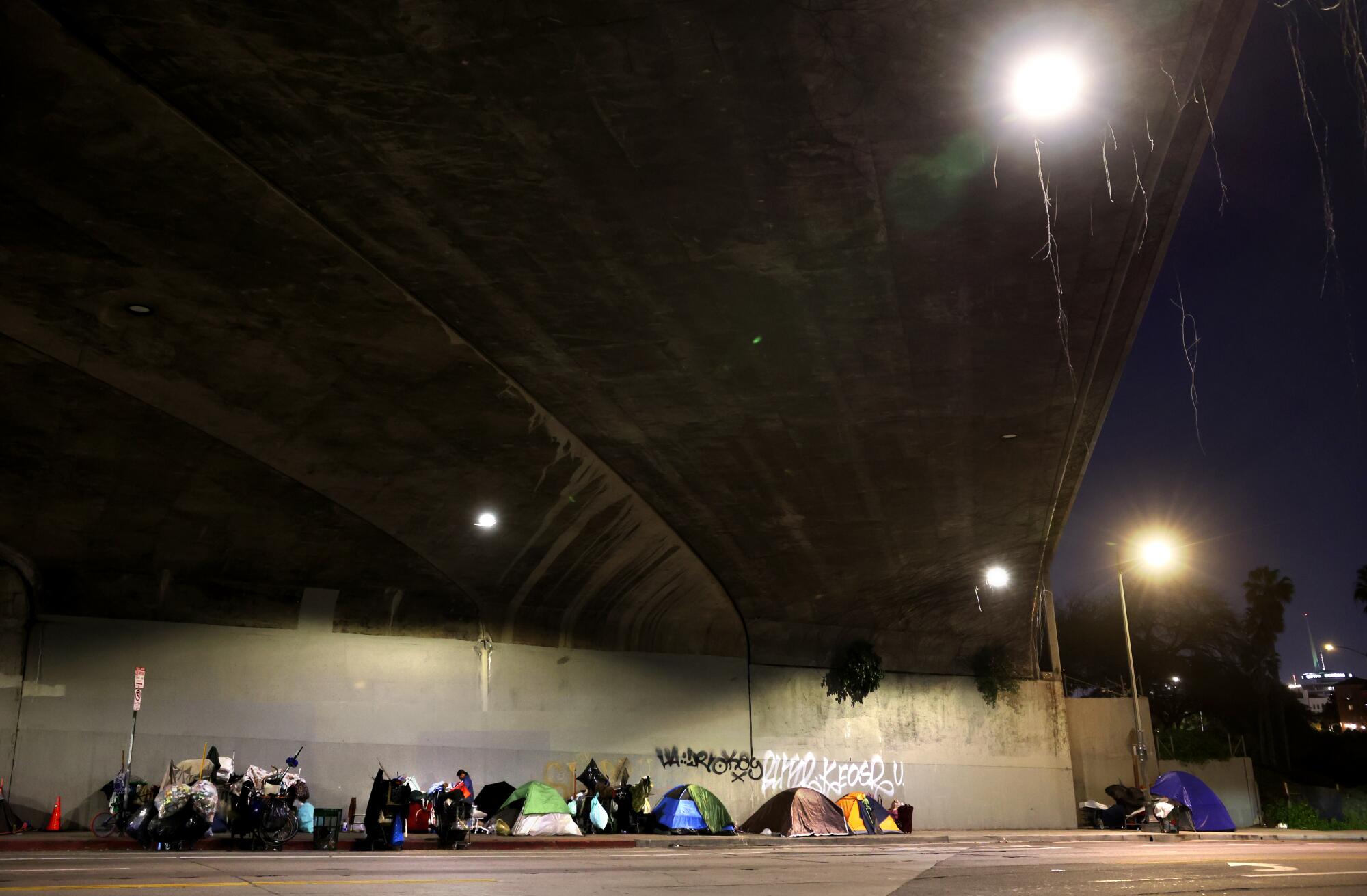
A homeless encampment under the 101 Freeway on Cahuenga Boulevard in Hollywood.
(Wally Skalij / Los Angeles Times)
On Friday, the Cahuenga area targeted by Inside Safe had 15 tents or tent-like structures. Bass, in a joint interview with Raman, acknowledged the neighborhood has been more challenging than many of the other locations visited by Inside Safe.
Bass said two unhoused residents refused to go inside — one of them facing mental health issues, the other involved in “criminal activity.” After a visit by Inside Safe in mid-January, they “assembled other people” at the encampment, she said.
“When we find that there is a criminal element, or people being harmed, then we have to address that accordingly,” Bass said. “We’ve not involved LAPD yet in this one, but we are looking into it, and we’ve heard of sex trafficking as well as drug trafficking.”
Raman, in an email, offered another reason for the return of the tents on Cahuenga: “We do not have the shelter resources we need for our homeless population.”
In the run-up to the March 5 election, Bass has been touting Raman’s record on homelessness, making personal appearances and providing video testimonials. In several campaign mailers, Bass said she consulted Raman early on about her work on homelessness. “I took what she said, and I have been using it since I assumed office.”
Bass and Raman have embraced a similar strategy: Send outreach workers and other specialists to homeless encampments to make offers of motel rooms, hotel rooms and other types of temporary housing — all on a voluntary basis — with a goal of moving those unhoused residents into permanent homes.
On Cahuenga and other nearby streets, that approach is being tested.
Sheridan Maki, who has been living for several months under a tarp-like structure on Franklin, said staffers in Raman’s office recently approached him about taking a room indoors. Even though the forecast for that week called for days of heavy rain, Maki declined the offer.
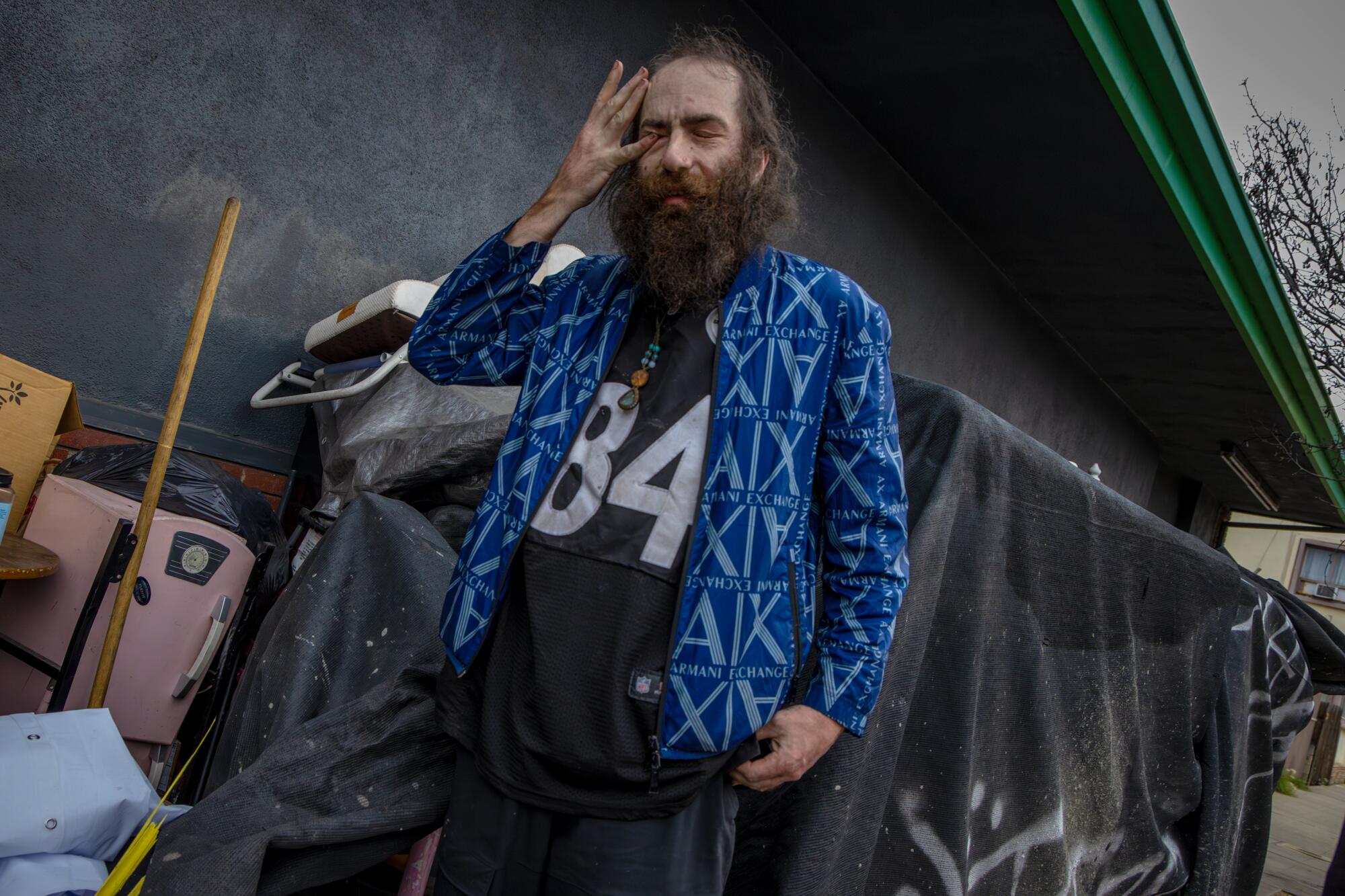
Sheridan Maki, who lives on Franklin Avenue, said staffers with Councilmember Nithya Raman have approached him to ask about moving indoors.
(Irfan Khan / Los Angeles Times)
“I told them I weather these storms pretty well, but I appreciate the ask,” he said.
Several unhoused residents who have lived on Cahuenga in recent months said they had already spent time in the city’s network of temporary housing facilities. One of them, who goes by the nickname “Rumple,” said he had been kicked out of two city-leased hotels, including the Highland Gardens, a facility that Raman worked to keep open.
Rumple said last week that he has three tents at the underpass, which are “currently occupied by others.” He argued that the encampment residents are unfairly being made into “the bad guy.”
“Hey, I’m sorry that it happens to be this bridge that we’ve chosen as a place to congregate,” he said in a text, “but we only have each other in this world.”
::
After years of living near the encampments, some of the neighborhood’s housed residents have begun demanding a strategy that will stick. They want Raman to begin using Municipal Code 41.18, which allows the council to designate freeway overpasses, parks and other locations as no-encampment zones.
Jeanie Griffin, who moved to the neighborhood in 2017 to be closer to her grandchildren, said the area’s homelessness problem has grown worse over the last seven years. Although some of the neighborhood’s homeless residents have been friendly, others have acted out in frightening ways — confronting passersby, yelling at cars or masturbating in public, she said.
Many have shown signs of serious methamphetamine use, Griffin said.
“They’re agitated. They’re combative. They’re talking to themselves,” she said.
Griffin, a therapist who specializes in addiction, said she no longer takes her grandchildren to nearby Franklin-Ivar Park and has stopped walking in the neighborhood altogether. She said she regrets voting for Raman in 2020, and is hoping Weaver will win the race and create new no-encampment zones.
Weaver, a former neighborhood prosecutor, said he is open to the idea, but would want to study the idea first.
“It would make sense to do it comprehensively if we’re going to do it at all,” he said.

Los Angeles City Councilmember Nithya Raman, left, talks with Mayor Karen Bass at one of her campaign events at Hazeltine Park in Sherman Oaks. Bass has been promoting Raman’s work on homelessness.
(Mel Melcon / Los Angeles Times)
Raman ruled out the idea, saying a no-camping zone would push unhoused residents “deeper into residential and business areas.”
“I’m really trying to find a pathway forward that will actually get people off the streets for good,” she said.
::
The fire that burned on Franklin last month was the second to occur in that location in recent months, neighbors say. In that spot, an encampment fire also broke out on Nov. 21, damaging two other cars, according to the Fire Department.
Weeks later, Bass was asked about the return of the tents on Cahuenga and other nearby streets. At an event marking her first year in office, she told reporters she would send outreach workers back to the neighborhood.
“I guarantee you, by the end of the year, all of those areas will be cleared too,” she said during the briefing.
David Zakaryan, who lives in the area, was out of town on Jan. 7, the night the fire broke out on Franklin. He returned days later to find his car was missing. After some phone calls, he found the yard where it had been hauled.
“It was burnt to a crisp,” he said.
Fire Department officials said they do not know how the blaze began. Zakaryan said that, even before the fire, he felt the neighborhood was becoming less safe.
After a friend in the neighborhood was chased by a shirtless man with a stick, Zakaryan advised her to start taking Uber to his apartment instead of walking.
::
Raman took office in December 2020, after ousting Councilmember David Ryu, a one-term incumbent. Her ballot title identified her as a “homelessness nonprofit leader” — a reference to her work founding the SELAH Neighborhood Homeless Coalition, a mutual aid group she helped found in her Silver Lake neighborhood.
After taking office, Raman assembled her homelessness team and began focusing on an array of large-scale encampments, some of which had exploded in size during the pandemic.
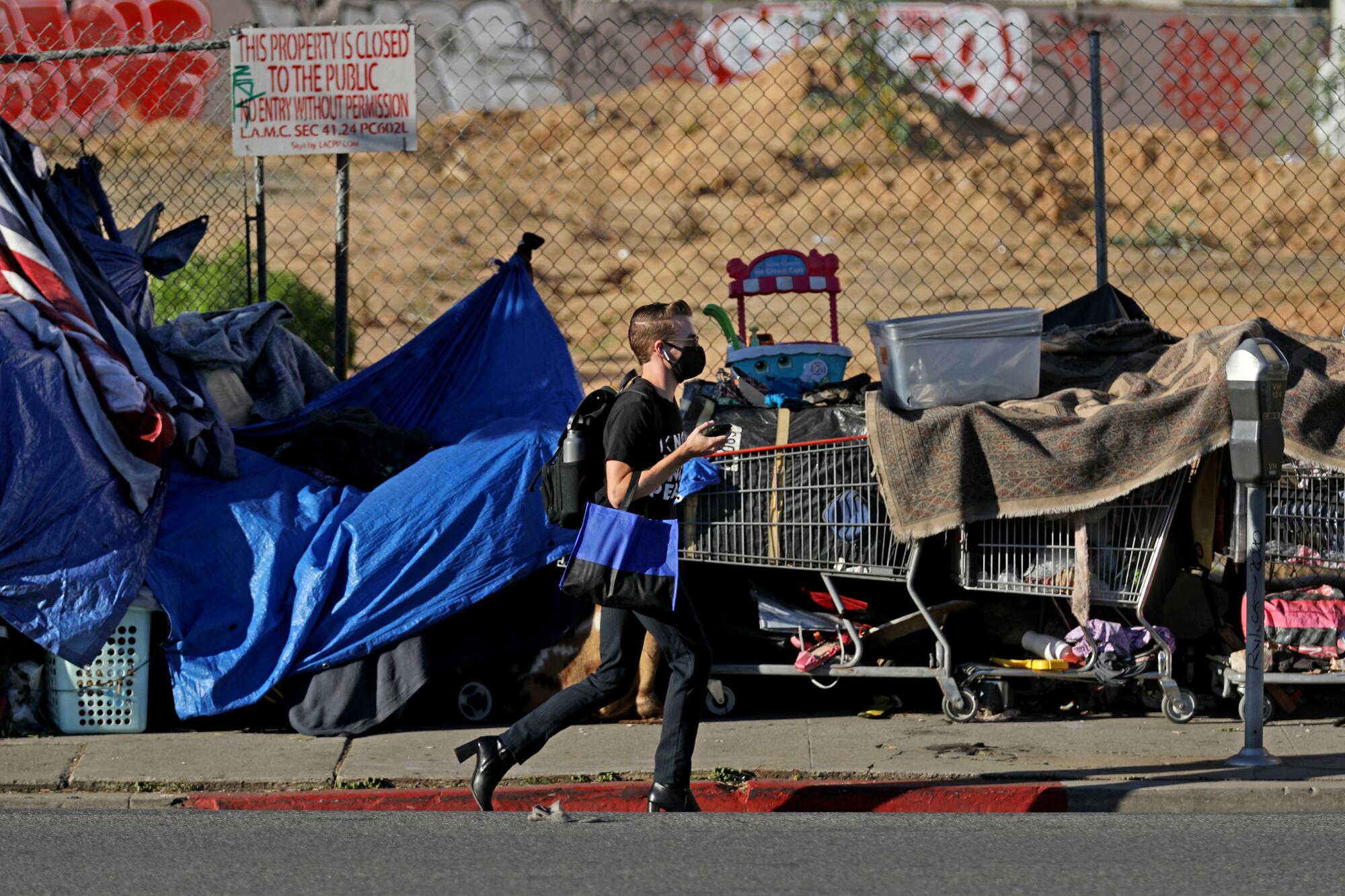
A pedestrian walks past a homeless encampment on Berendo Street in 2021. Since then, Councilmember Nithya Raman worked to move those unhoused residents indoors, restoring access to the sidewalk.
(Gary Coronado / Los Angeles Times)
In Los Feliz, her team successfully cleared an encampment on Berendo Street, where anger over homelessness and crime helped fuel an unsuccessful recall attempt. In Sherman Oaks, outreach workers relocated unhoused residents from Coldwater Canyon Avenue at the 101.
After her district’s boundaries were redrawn in 2021, Raman focused on encampments that had spilled onto residential streets near a Studio City park-and-ride lot.
None of those efforts, Raman said, required the use of 41.18, which allows council members to prohibit encampments within 500 feet of “sensitive” locations, such as freeway overpasses.
As the city emerged from the pandemic, residents on and around Cahuenga began demanding that the city restore access to their local sidewalks. Some had grown frustrated with having to walk alongside cars on Cahuenga and other streets.
Raman’s team moved 44 homeless people indoors from the area in February 2022. That same year, encampments had taken over a median strip owned by the city at Cahuenga, Franklin and Wilcox Avenue — a triangle-shaped site featuring a vertical Hollywood sign and a veterans memorial.
Once those unhoused residents were relocated, the city fenced off the triangle to allow workers to put in new plantings and repair the site’s irrigation and electrical system.
Almost two years later, the fence remains. On Jan. 28, firefighters responded to a blaze at an encampment right outside the fence. A second fire broke out 50 minutes later at the same location. Firefighters put that out too.
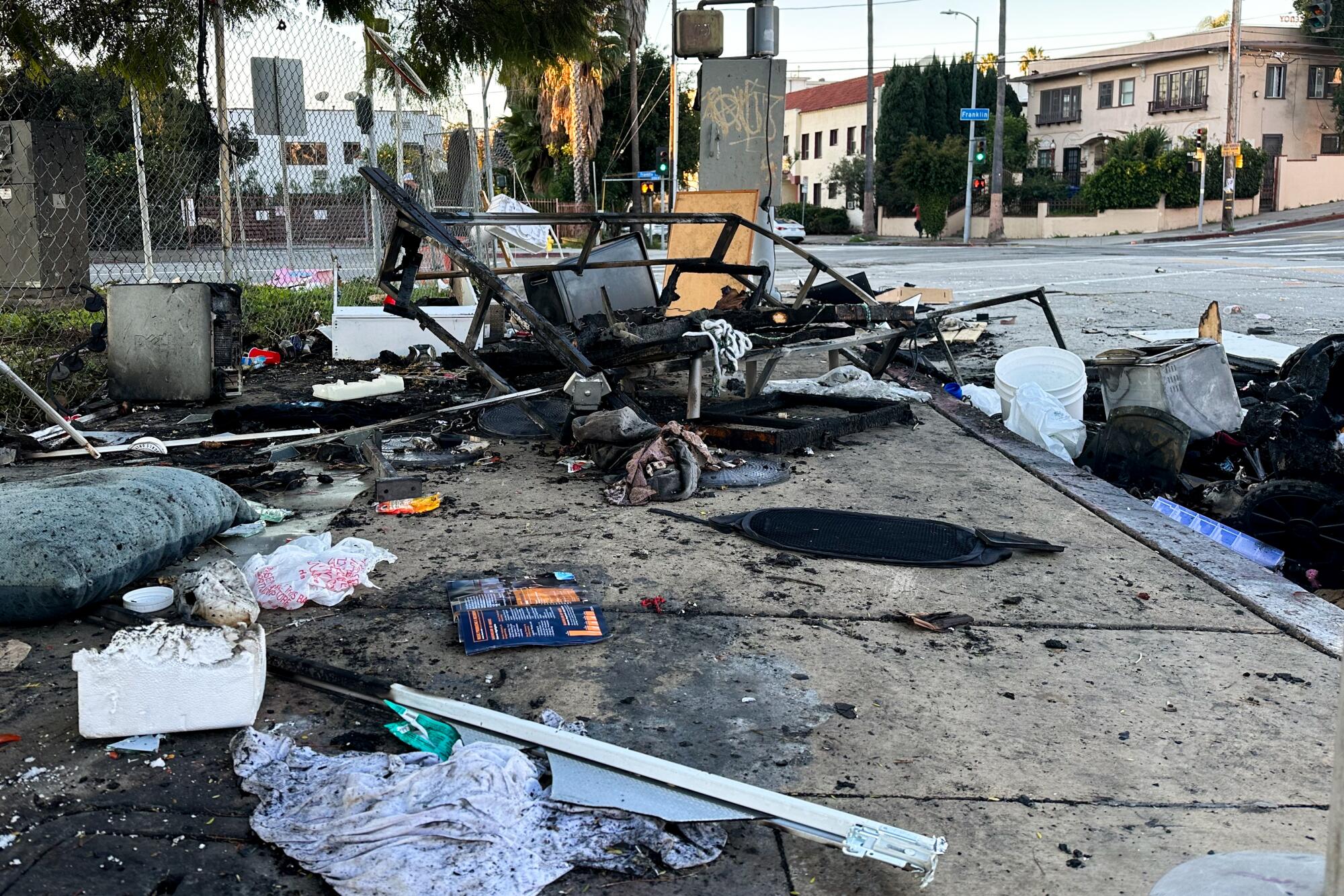
A burned-out encampment at Wilcox and Franklin avenues in Hollywood on Jan. 29.
(David Zahniser / Los Angeles Times)
No one was injured in either incident and a cause has not been determined, fire officials said in an email.
::
Bass took office in December 2022, after a mayoral campaign dominated by the issue of homelessness. She launched Inside Safe the following week, making the Cahuenga corridor her first target.
Outreach workers moved residents indoors from the 101 Freeway overpass, the Cahuenga/Wilcox triangle and at Franklin and Ivar, according to maps provided by the mayor’s office. Once the operation was finished, fences went up on the sidewalk on both sides of the overpass, leaving a narrow space for pedestrians. Neighbors were delighted.
By the time the fences came down two months later, an encampment had taken hold on Franklin. By summer, a small group also had set up tents on Dix Street, a narrow residential street between Franklin and the freeway.
Neighbors on Dix reacted with alarm over what they described as heavy drug use, discarded needles and late-night partying. In August, a 30-year-old man died on the sidewalk from a fatal overdose, according to the Los Angeles County coroner’s office.
Newsletter
Get the lowdown on L.A. politics
Sign up for our L.A. City Hall newsletter to get weekly insights, scoops and analysis.
You may occasionally receive promotional content from the Los Angeles Times.
Debra Gainor, who owns two rental units on the block, said she reached out to Raman’s office about the issues at the encampment. Raman’s office scheduled a cleanup and a tree trimming to reduce the potential for fire, Gainor said.
In November, paramedics responded to a second, nonfatal overdose. Days later, Gainor decided to take matters into her own hands, approaching the unhoused residents on Dix during one of the city’s encampment cleanups.
With city workers nearby, Gainor asked the group if they would be willing to move to another street.
“I asked the encampment guys, ‘Can you please give us a break?’” she said. “I said, ‘You are living in front of an elderly lady’s home, and she is having a very hard time sleeping. You stay up late at night and sleep during the day.’”
One day later, Gainor said, the group relocated to the Cahuenga/101 Freeway overpass. At least one accepted an offer of housing from the city soon afterward, she said.
Gainor said she has been focused since then on the spate of encampment fires. At this point, she intends to vote for Weaver. “We’re exhausted dealing with this,” she said.
Bass, in an interview, said she believes the city will have more tools to address the problems in the neighborhood after March 5, when voters will have taken up Proposition 1, a state measure to provide housing and services for those battling mental illness.
Asked about the complaints from neighbors, she said: “They couldn’t possibly be more frustrated than the councilwoman and myself.”
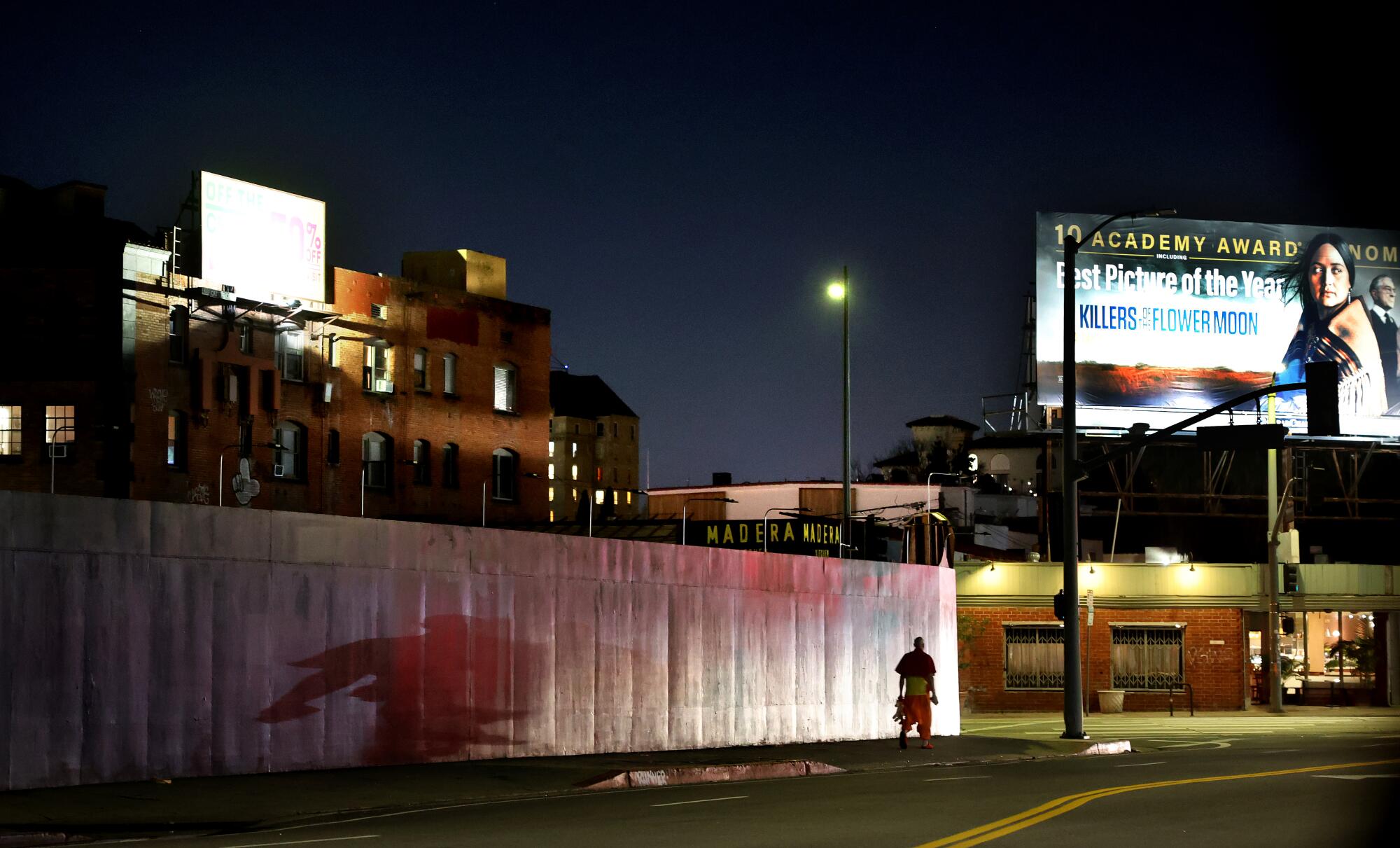
A stretch of Cahuenga Boulevard in Hollywood.
(Wally Skalij / Los Angeles Times)
Raman said she has secured additional mental health services for the area’s unhoused residents.
“The places where we have [unhoused] individuals repopulate tend to be people who have deeper mental health challenges,” she said. “This site has been no different.”
Calvin Madrid, 33, said he is ready for those services. Sitting under the 101 Freeway on Thursday, he said he has been on the street for 16 years, struggling with schizophrenia, post-traumatic stress disorder and other mental health issues.
“I want to get an apartment again,” he said.
This story originally appeared on LA Times

